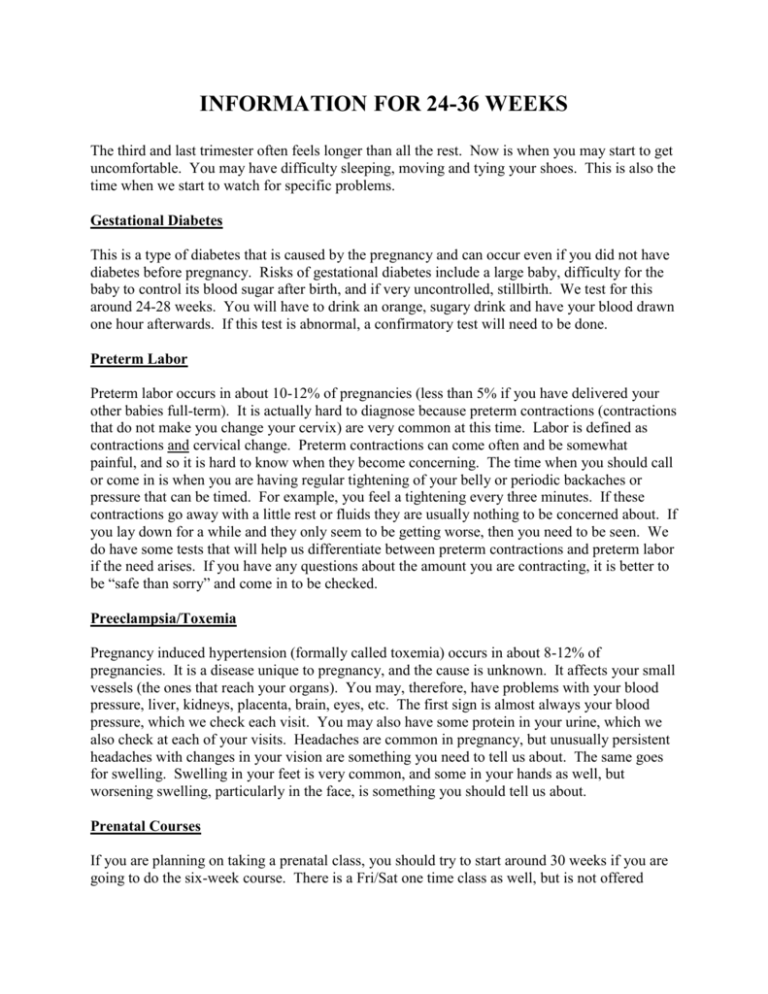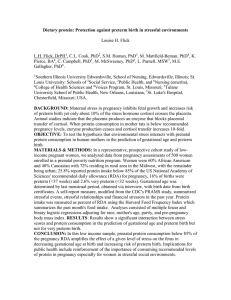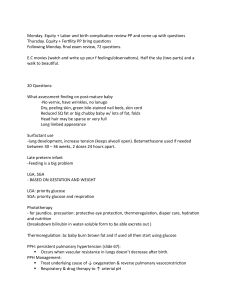Prenatal Instructions 24-36 Weeks
advertisement

INFORMATION FOR 24-36 WEEKS The third and last trimester often feels longer than all the rest. Now is when you may start to get uncomfortable. You may have difficulty sleeping, moving and tying your shoes. This is also the time when we start to watch for specific problems. Gestational Diabetes This is a type of diabetes that is caused by the pregnancy and can occur even if you did not have diabetes before pregnancy. Risks of gestational diabetes include a large baby, difficulty for the baby to control its blood sugar after birth, and if very uncontrolled, stillbirth. We test for this around 24-28 weeks. You will have to drink an orange, sugary drink and have your blood drawn one hour afterwards. If this test is abnormal, a confirmatory test will need to be done. Preterm Labor Preterm labor occurs in about 10-12% of pregnancies (less than 5% if you have delivered your other babies full-term). It is actually hard to diagnose because preterm contractions (contractions that do not make you change your cervix) are very common at this time. Labor is defined as contractions and cervical change. Preterm contractions can come often and be somewhat painful, and so it is hard to know when they become concerning. The time when you should call or come in is when you are having regular tightening of your belly or periodic backaches or pressure that can be timed. For example, you feel a tightening every three minutes. If these contractions go away with a little rest or fluids they are usually nothing to be concerned about. If you lay down for a while and they only seem to be getting worse, then you need to be seen. We do have some tests that will help us differentiate between preterm contractions and preterm labor if the need arises. If you have any questions about the amount you are contracting, it is better to be “safe than sorry” and come in to be checked. Preeclampsia/Toxemia Pregnancy induced hypertension (formally called toxemia) occurs in about 8-12% of pregnancies. It is a disease unique to pregnancy, and the cause is unknown. It affects your small vessels (the ones that reach your organs). You may, therefore, have problems with your blood pressure, liver, kidneys, placenta, brain, eyes, etc. The first sign is almost always your blood pressure, which we check each visit. You may also have some protein in your urine, which we also check at each of your visits. Headaches are common in pregnancy, but unusually persistent headaches with changes in your vision are something you need to tell us about. The same goes for swelling. Swelling in your feet is very common, and some in your hands as well, but worsening swelling, particularly in the face, is something you should tell us about. Prenatal Courses If you are planning on taking a prenatal class, you should try to start around 30 weeks if you are going to do the six-week course. There is a Fri/Sat one time class as well, but is not offered every weekend. If you cannot make a class, you are welcome to stop by labor and delivery and ask for a tour. Then we can answer questions in the office about pain control, etc… Back Pain/Sciatica As your baby grows, you will probably get more back pain and perhaps even pain and numbness shooting down your leg. This is due to your baby and uterus putting pressure on your sciatic nerve and, unfortunately, may not go away until you deliver. You may try ice, heat and/or Tylenol as well. I prefer that you do not use ibuprofen at this point in your pregnancy. Fetal Movement After 28 weeks, you should start to count your baby’s movements each day. Babies sleep a lot of the time. However, at least once each day, when your baby is most active, you should be able to count at least ten movements in one hour. If this does not occur, call our office or labor and delivery. RhoGAM If you have a negative blood type, you will need an injection of RhoGAM around 28 weeks to protect future pregnancies from anti-bodies that your body might create. You will also need a 2nd RhoGAM injection after you deliver. Birth Control Options We will discuss these options with you at your post-partum visit six weeks after you deliver. However, if you are considering a tubal ligation, some insurances require completion of a consent form one month prior to the procedure. If you need to discuss this, just ask.











